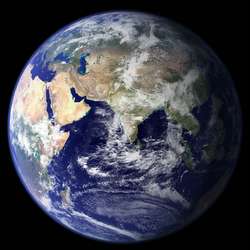“Snowball Earth” proponents, who say that Earth’s oceans were long ago covered by thick ice, explain the survival of life by hypothesizing the existence of small warm spots, or refugia. On the other side, supporters of a “Slushball Earth” say the planet included large areas of thin ice or open ocean, particularly around the equator.
Now, scientists who applied innovative techniques to previously unexamined rock formations have turned up strong evidence to support the “Slushball Earth” side of the decades-long scientific debate.
The study appears in the Sept. 29 online Science Express
The debate has tended to revolve around the same rock samples and analytical techniques, said Alison Olcott, an earth scientist at the University of Southern California. So she and her team focused on a drill core of little-known black shale deposits from southeastern Brazil and applied lipid biomarker techniques to identify prehistoric organisms based on the fatty remains of their cell membranes.
“This evidence for life in parts of the global oceans requires a revision of our interpretations related to this period of low-latitude glaciation,” said Enriqueta Barrera, program director in the National Science Foundation’s (NSF) Division of Earth Sciences, which funded the research.
The team, which included scientists from USC, Caltech, the University of Maryland and a Brazilian mining company, identified a complex and productive microbial ecosystem, including photosynthesizing organisms that could not have existed under a thick layer of ice.
“If there were ice, it had to have been thin enough that organisms could photosynthesize below it or within it,” Olcott said.
Frank Corsetti of USC, a co-author on the study, said “this is the first real evidence that substantial photosynthesis occurred in the Earth’s oceans during the extreme ice age 700 million years ago, which is a challenge for the snowball theory.”
The evidence does not prove large parts of the ocean remained free of sheet ice during the pre-Cambrian glaciation. Although unlikely, Olcott said it is possible one of the tiny “refugia” under the “Snowball Earth” hypothesis allowed such marine life to exist.
But, she said, “finding the one anomalous spot would be quite unlikely,” adding that the samples she studied came from an extensive formation of rocks with similar characteristics.
“At what point does an enormous refugium become open ocean?” she asked.
Skeptics also may argue that the rocks do not necessarily date to a glacial era, Olcott said. But the team found evidence of glacial activity in the samples, such as dropstones (continental rocks dropped by melting glaciers into marine deposits) and glendonites (minerals that only form in near-freezing water).
“Geologists don’t necessarily think of looking for traces of microbes left in the rocks. This is the first direct look at the ecosystem during this time period,” said Olcott, who credited USC’s geobiology program, one of a handful in the country, with influencing her thinking.
Original Source: NSF News Release


Hey, nice tips. I’ll buy a bottle of beer to that person from that forum who told me to visit your blog 🙂